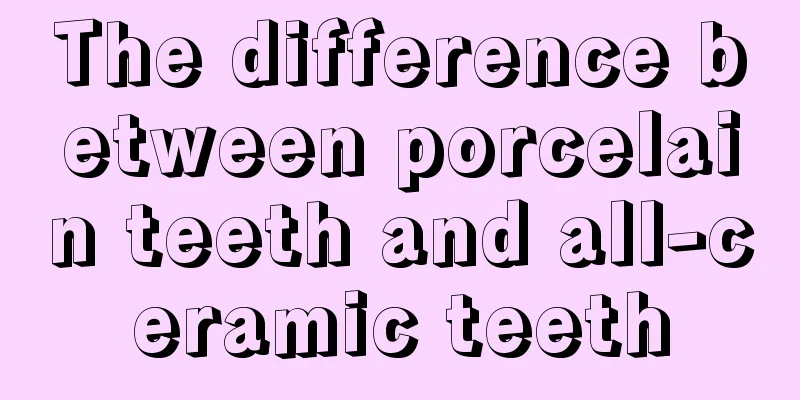The difference between porcelain teeth and all-ceramic teeth

|
There is still a difference between porcelain teeth and all-ceramic teeth, because there are many types of porcelain teeth in life, and different types have different prices. So when we choose porcelain teeth, we must choose what kind of material to use for ourselves based on our personal economic strength. What are the differences between them? Category classification Porcelain teeth are composed of two layers: an inner metal base layer and an outer porcelain layer. They are divided into three categories according to the different materials of the metal base crowns: precious metal alloy porcelain crowns (represented by gold alloy porcelain crowns), non-precious metal alloy porcelain crowns (represented by nickel-chromium alloy porcelain crowns and cobalt-chromium alloy porcelain crowns), and titanium alloy porcelain crowns. 1. Precious metal alloy porcelain crown: Porcelain crowns made of precious metals are called precious metal porcelain crowns. Precious metals have good chemical inertness, making them resistant to oxidation and corrosion. The most commonly used precious metals in dentistry include: gold, platinum, palladium, etc. 2. Non-precious metal alloy porcelain crown: Porcelain crowns made of non-precious metals as metal base crowns are called non-precious metal porcelain crowns. Non-precious metals are easily oxidized at high temperatures and have relatively weak corrosion resistance, especially in a humid oral environment. Metal ions are easily precipitated, which may cause gray discoloration of the gums. Some metals are also allergenic. The most commonly used non-precious metals in dentistry include: nickel, chromium, cobalt, aluminum, etc. 3. Titanium alloy porcelain crown: Titanium should belong to the category of non-precious metals, but because it has many different properties, it is listed separately. Titanium has the advantages of good biocompatibility, corrosion resistance, and low thermal conductivity. However, due to its high melting point, difficult casting process, easy oxidation, relatively poor bonding between the metal base and the porcelain layer, easy collapse of the porcelain layer, and the need to use special porcelain powder processing, its wide application is limited. Not suitable for people 1. If other relatively less molar restoration methods can meet the patient's requirements for beauty and strength, it is not recommended to use gold-ceramic crown restoration; 2. For those who have extremely high requirements for the beauty of the front teeth, avoid using metal porcelain crowns that may cause gray lines on the neck, such as nickel-chromium alloy porcelain crowns; 3. People who are allergic to metals should not use non-precious metal porcelain crowns. Precious metal porcelain crowns should be used with caution. 4. It is contraindicated for use on young permanent teeth that have not yet fully developed; 5. If the tooth is too small to provide sufficient retention and resistance, it is contraindicated to use metal porcelain crowns directly for restoration; |
<<: Successful experience in preparing for twin boy-girl pregnancy
>>: Successful experience of natural cycle transplantation
Recommend
What to do if you have diarrhea due to uremia
Uremia is a very serious disease. It is a syndrom...
The correct way to use the coarse salt hot compress pack
Coarse salt hot compress packs are very effective...
What are some methods to relieve asthma?
Asthma is an extremely harmful disease. Once an a...
How to treat advanced liver cancer
The patient is a 64-year-old male with advanced l...
Signs of a person without a strong opinion
For people who have no opinions, there are often ...
How to regulate diet for advanced liver cancer? Three principles of dietary regulation for advanced liver cancer
The mortality rate of liver cancer is very high. ...
Why should the first sweat steaming be continuous
When we go to the bathroom to take a shower, we w...
What kind of tea is good for liver health?
In daily life, the liver is a critical organ for ...
Adverse reactions after bile duct stent surgery? Do you know these reactions?
Patients with bile duct cancer or other malignanc...
Can eating loquat raw relieve cough?
Cough is a common symptom and a disease that many...
Which type of lung cancer is more harmful
Which type of lung cancer is more harmful? Small ...
What is pseudomyopia? It has these characteristics
There are two types of myopia: false and true. Fa...
What to do if genital herpes recurs? Be careful of treatment misunderstandings
Genital herpes is extremely harmful to patients a...
How to tell if eyelashes are growing backwards
In our lives, many people have eyelashes that gro...
Will it hurt in the late stage of brain cancer?
Dizziness may occur in the early stage of brain c...









